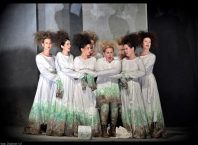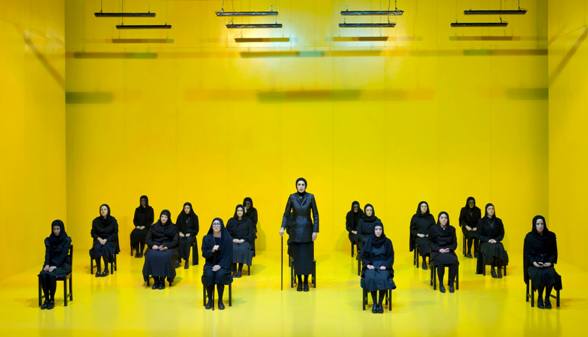
Gadi Roll’s edgy and visceral staging of The House of Bernarda Alba creates a searing portrait of women confined within the customs and beliefs of an oppressive society. A strong all-female cast delivers an excellent ensemble performance, bringing Lorca’s play to vivid life in the Beer Sheva Theatre production.
The formal elements of the play – color, design, composition, sound and movement – are striking, and complement the fierce emotions at work. One is instantly confronted by Roni Toren’s bold set, high yellow walls and yellow floor, lit with an almost glaring brightness, with several straight-back black chairs set out at random. The effect is very stark and modern; in dramatic contrast to the dominance of old, oppressive traditions in this rural village.
This is the house of Bernarda Alba (Idit Teperson), whose second husband has died, leaving her with five daughters, ages 20 – 39, all unmarried. The customs of mourning are wonderfully choreographed as the women of this rural village enter to pay their respects after the funeral, black figures on black chairs against a yellow background. The smallest glimmer of a smile appears on the face of the woman sitting at the end of the first row, she whips out a black fan. This is the eldest daughter, Angustias (Shiri Golan), she has her reasons for smiling. One after another, the fans snap open in a dance of endurance, yet there is no escaping this heat. The yellow walls surround the women as does the overpowering heat of the sun, symbolically perhaps a reminder of what Bernarda lacks in this male-dominated culture: a son.
Bernarda swears that “no breeze shall enter this house,” it will be closed up in mourning for eight years, as was the custom of her father and grandfather. No wind will enter and not much light, either literally or figuratively. This rural town is “cursed,” it has no rivers or wells, it is dry and barren, as are the women in this house. The women in this play are all trapped, by the norms of society and their own social status within this culture. Men can literally do anything, but a woman is the object of constant scrutiny and gossip, and appearances must be kept up at all costs.
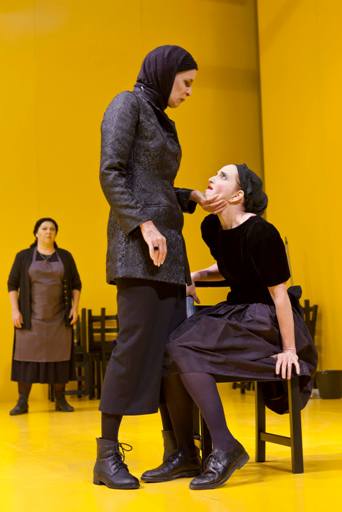
Idit Teperson’s Bernarda literally towers over the others, a stern, imposing, almost cadaverous figure, her word is law. She is fearsome to behold, and yet, tragically flawed, she cannot acknowledge her own limitations; she too is trapped. All she can do is deny herself all that she denies her daughters: the truth of her feelings.
The five girls, denied any freedom to dream and grow, are all twisted, emotionally stunted, each distorted in some way. The heat of their repressed sexuality simmers beneath the surface, as they vie for any small share of pleasure, even if it is only looking out the window as the men talk at the gate. The eldest, Angustias (Shiri Golan), pushing forty, a timid, pale, childish woman who never had a chance to bloom, yet desperately clutches at the illusive possibility of happiness. Unlike the others, she has been left with some money, which gives her a chance to marry. Golan’s ability to immerse herself so completely in this role is utterly captivating.
There is a wonderful tension between what is seen and what is not seen onstage, what is said openly and what is concealed; connecting closely to the motif of “appearances” that are so crucial in this play. The would-be suitor, the handsome young Pepe El Romano remains an offstage character, much discussed, yet never seen. It is a profoundly visual and physical play, much is conveyed through the way each character holds her body, moves, gestures; the silences express as much as the dialogues.
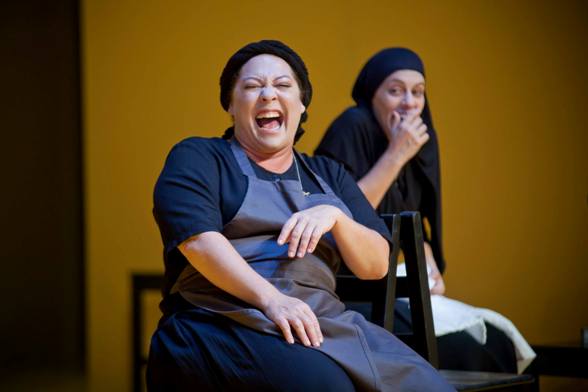
Poncia (Naama Shapira), the housekeeper, is and is not a member of the family. She too is trapped by her social standing, yet at the same time, her lower status gives her the ability to observe and comment freely; after all, she does not have much to lose. Sitting legs wide apart, laughing loudly, speaking her mind, Poncia offers some relief from the grim severity of Bernarda’s domain. Martirio’s (Liraz Chamami) feelings, like a flower trying to grow through concrete, become twisted and diseased; her agitated, twisted form reflecting the inner turmoil of her mind. Angustias’ clownish attempt at makeup accentuates the distance between her desires and her ability to fulfill them, between the illusions she tries ineffectually to perpetuate, and her reality.
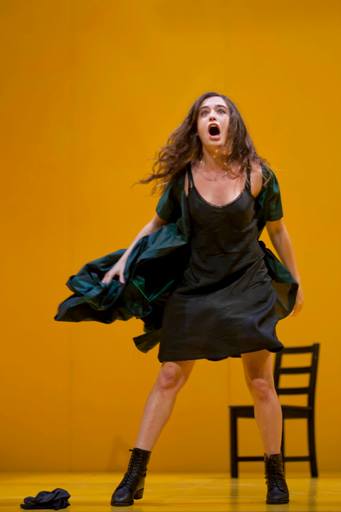
The only one who has not yet had the spirit beaten out of her is the youngest, Adela. Avigail Harari conveys the irrepressible sexuality and savage fervor of Adela with touching beauty. In her innocence, she believes she is sly enough to triumph over the constraints of her situation. Forced into such a narrow existence, the girls are both allies and rivals. The tensions, jealousies and rivalries between them are always simmering beneath the surface, as does their resentment of Bernarda. In this house, there is no warmth, there is only heat.
The House of Bernarda Alba by Federico García Lorca
Translated by Rivka Meshulach; Directed by Gadi Roll; Set Design: Roni Toren; Costumes: Yehudit Aharon; Lighting: Felice Ross; Music: Eldad Lidor; Cast: Liron Ben Zaken (maid); Naama Shapira (Poncia); Yael Eitan (Amelia); Avigail Harari (Adela); Liraz Chamami (Martirio); Orel Maor (Magdalena); Idit Teperson (Bernarda Alba); Shiri Golan (Angustias); Ora Meirson (Maria Josefa); Orly Tobaly (Prudencia).





